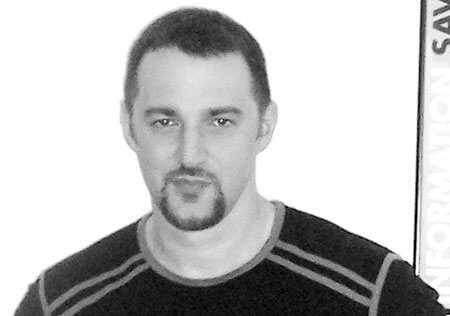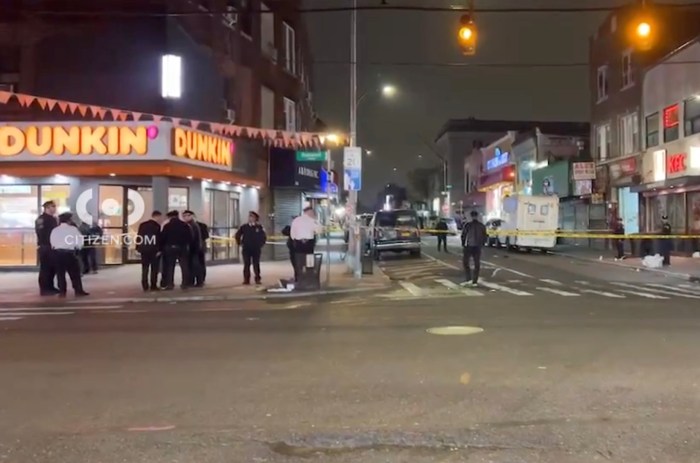VOLUME 3, ISSUE 344 | November 4 – November11, 2004
COMMUNITY
Forum Focuses on Queer Homeless Youth
NYU event draws together experts and young people who have lived on the streets
Carl Siciliano, who runs Ali Forney Center, which provides emergency beds for homeless queer youth in Harlem and Hells Kitchen, terms the state of New York’s response to the issue as a “profound tragedy.”
Dressed in a black blazer and a skirt, Johnnie Ray Artis, 23, known to friends and acquaintances as Charlene, stood in front of about 70 people at New York University’s Cantor Film Center last Thursday evening.
“My words are gonna be harsh––even though I don’t do this often,” she began, taking a deep breath.
Artis was one of four homeless young people who spoke at a community discussion held October 28 on lesbian, gay, bisexual and transgendered (LGBT) youth who find themselves living on the streets. The discussion, organized by The Queer Economic Justice Network in cooperation with a host of homeless and gay advocacy groups, included a youth speak-out, a panel presentation by experts in the field and an interactive question and answer session.
Artis continued her story, saying that she was born to parents who were comfortable economically, but that “things began to go downhill” when her father died. After becoming homeless, the first shelter she found her way to with a friend was Covenant House, the city’s largest facility, located in Chelsea. She thought she could trust her friend, and told him that she was bisexual. Soon, she began to be abused verbally and physically. At one point, she said, the other youths in the shelter threw batteries at her. Artis complained to the staff, but Covenant House officials said they saw no evidence that she faced harassment, despite, she noted, the presence of video cameras in the facility. That’s when she decided to live on the streets and resorted to sex work to support herself.
“The first time I went on the streets,” Artis said, “I had a gun held to my head and guys forced me to suck on their penis—without a condom—and I had to swallow. And after that they robbed me.”
After living on the streets as a sex worker for some time, she went to the Neutral Zone, a drop-in center for LGBT youth located on East 33rd Street, a facility which she said provided a lot of help. She added that two homeless shelters where she was able to live as an openly queer youth—Green Chimneys in Grammercy Park and The Ali Forney Center, which has facilities in Harlem and Hells Kitchen and where she currently resides—“turned her life around.”
Kia Chiquita Jefferson, a 19-year-old homeless lesbian, was “kicked out” of her home at 17. Jefferson is out to her mother, who is accepting of her sexuality, but her stepfather isn’t.
“You have to find places,” she said. “There’s no sign which says ‘We help LGBT people here’. If you’re from outside the city, nobody’s offerin’ you help. No way you know when you gonna eat, sleep, shower. You wear the same clothes for two weeks. No people cater to young LGBTs.”
Javed Lallan, 22, a Guyanese gay man, has been homeless for four months, since his most recent birthday, when he came out to his parents.
“When I told my mother I was gay, she called the NYPD, since I was over 21,” he said, explaining she no longer wanted him in the house.
Lallan slept on the subway that night.
“It could happen to anybody, but not to me,” he said, sighing. “But circumstances don’t discriminate.”
Lallan described his experience as “mind boggling,” saying that he gets up in his shelter by 8:45 a.m., and has nowhere to go, nothing to eat until the evenings. In conclusion, he said, welling up, “If I didn’t come out, I would still have a home, but I need peace of mind, and I keep telling my friends it’s easier to be gay than homeless.”
Angel R. Seda, a 23-year-old gay man, who is no longer homeless, but was part of the shelter system for several years, said that his mother kicked him out at 15.
“She adopted me when she was in her 50s or 60s and, I guess, she couldn’t deal with an unstable rebellious teenager,” he said.
Artis, Jefferson and Seda, who have all experienced homelessness for at least two years, echoed each others’ views that they had suffered severe homophobia at general population youth shelters like Covenant House. Each acknowledged that they were forced to resort to sex work to survive.
After coming in contact with the limited resources available for homeless LGBT youths in New York, all three reported dramatic improvement in their lives.
The expert panel—which included Diana Olaizola from the Coalition for the Homeless, Anya Mukarji-Connoly, a lawyer with the Peter M. Cicchino Youth Project, Michele Eichorn, a social worker and director of the Neutral Zone and Cark Siciliano, director and founder of the Ali Forney Center—confirmed the experiences described by the youths with a battery of statistics. They also talked about the roots of the problems facing homeless queer youth in New York.
Olaizola spoke about the limited availability of beds in homeless centers that are safe places for homeless LGBT youths—they number only 22 in a city where it is estimated that as many as 40 percent of all homeless youth are queer-identified. Panelists said that although the few beds that are available enjoy some state and federal funding, virtually no city funds have been devoted to easing the crunch.
Mukarji-Connoly emphasized the need for training homeless advocates and professionals about the special needs LGBT youth present. She described the current system as “at best insensitive,” recounting examples of the kind of harassment faced by queer youth. She advocated a policy of zero tolerance for homophobia in the shelter system, but also said that teaching self-sufficiency to homeless queer youth was important. The Peter Cicchino Youth Project, with which Mukarji-Connoly is associated, provides legal services to low-income LGBT youth.
Eichorn, the director of the Neutral Zone, spoke about the scant mental health services currently available in the homeless shelters. She mentioned that a study conducted by the University of Kansas estimated that somewhere between six and 13 percent of straight homeless youth attempt suicide, but that up to 40 percent of homeless youth who are LGBT-identified had attempted suicide, some on multiple occasions. As did the other expert panelists, Eichorn emphasized the lack of funding available for LGBT homeless young people.
Carl Siciliano, who founded the Ali Forney Center in 2002 after a long career in youth homeless services, described the state of services for queer youth on New York’s streets as a “profound tragedy.” He emphasized that since state and federal money is used to fund homeless shelters, the tolerance for homophobia in many of the general population facilities represented unacceptable discrimination. Siciliano, as he often does, also discussed the responsibility that the adult LGBT community has for focusing on the problem of homeless among its youth and in working to find solutions.
For more information about homelessness among queer youth and the organizations discussed in this article, visit coalitionforthehomeless.org, petercicchino.org, greenchimneys.org and aliforneycenter.org. To reach the Neutral Zone, call 646-935-1943, and to reach Sylvia’s Place, another shelter for LGBT youth, call 212-629-7440.


































